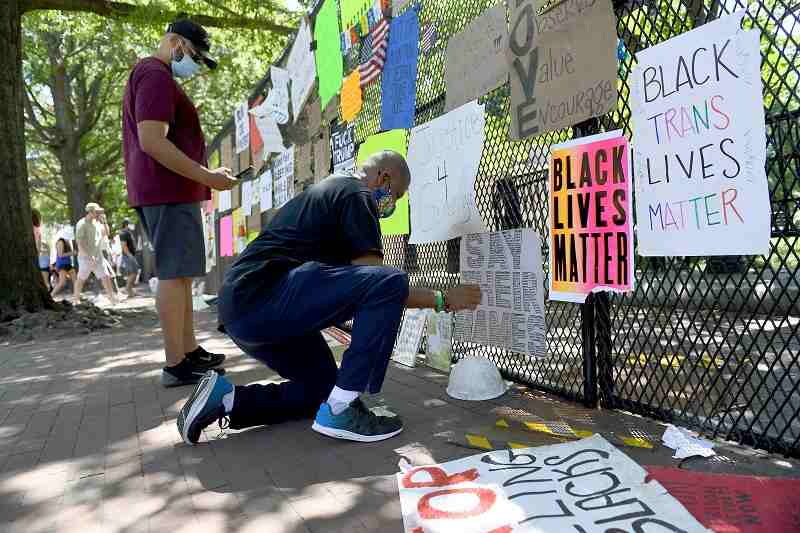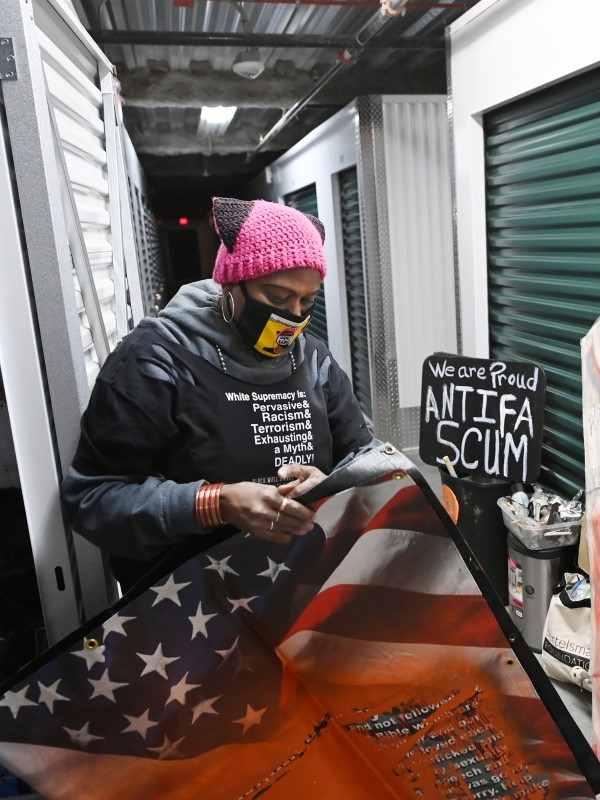A White House fence’s Black Lives Matter art has been saved for history

Harold McQuillia, an officer with the Department of Homeland Security, photographs items on and beside the fence surrounding the White House on his day off in June 2020.
11:58 JST, October 3, 2022
WASHINGTON – His 11-year-old son wanted to protest, so Marcus Gould drove him to the nation’s capital to join the thousands of people decrying the police killing of George Floyd and demanding an end to racism.
They walked to the White House and were met by a tall metal fence covered in banners, posters and other artwork with impassioned pleas for justice. In that moment, Gould said, he felt as if he was staring at history – and felt inspired to be a part of it.
The next month, Gould, who is Black, returned to D.C. from New Jersey with a banner depicting a twist on the Monopoly “go to jail” card. On it, the Monopoly Man, whom he drew as Black, was holding the club and hauling away the policeman. Next to the image, it read “You Kill Go StR8 2 Jail!”
Gould walked up to the fence, looped zip ties through the corners, and thought that would solidify its place until authorities came through and threw everything away.
But Gould’s banner – and 1,601 other artifacts from the Black Lives Matter Memorial Fence – was saved. More than two years after he attached it to the fence, it was scanned, archived and published Friday in an online collection on Dig DC, the D.C. Public Library’s online archive.
“There was no way I thought it would still be in existence,” said Gould, a 45-year-old artist from Jersey City. “It’s just an amazing feeling that people are going to be able to interact with it, share it, put it on their screen savers or something. It’s out there for the world to enjoy.”
The new online archive is the most comprehensive look yet at the ways the Black Lives Matter Memorial Fence became an art gallery of resistance, representing the outpouring of grief and anger among thousands of people in D.C. protesting racism and police brutality.

Nadine Seiler, 57, spent hours in a 5-by-10-foot storage unit in Northeast Washington, organizing and handpicking pieces of art from the fence to be archived.
The artifacts trumpeted a range of causes, including many declarations of “Black Lives Matter” on posters, a shield, a flag, face masks and photos of people who were killed by police. There were also signs demanding that leaders cancel rent, “count every vote” and defend democracy; signs with obscenities about the Proud Boys, a far-right group with a history of violence; and signs advocating for other social justice and human rights issues.
They feature the names of 373 people, most of whom were victims of police brutality, said Laura Farley, a digital curation librarian at the D.C. Public Library. They feature more than a dozen languages, too, including Arabic, German, French, Haitian Creole, Croatian, Lakota, Norwegian, Russian, Spanish and Urdu.
“The fence was the outlet for Black people to feel their anger, their frustration, their love, their aspirations for us as a people, for when finally people would see us with some humanity,” said Nadine Seiler, a Black resident of Waldorf, Md., who played a leading role in the archival effort.
On June 1, 2020, law enforcement officers forcibly cleared hundreds of peaceful demonstrators outside the White House, firing rubber bullets and chemical gas amid protests over the police murder of George Floyd. Shortly after, President Donald Trump walked through Lafayette Square for a photo op at St. John’s Church.
The next day, the black chain-link fence went up around the square, and one of the first signs hung on it, according to Seiler, read “I can’t breathe,” Floyd’s dying words.
Federal law enforcement reopened the park that same month, but it was soon closed off again with tall fencing, reinforced by concrete barriers. Though history is usually thought of as a distant past, Seiler recognized that the fence’s transformation from a barrier to control protesters into a growing art collection of defiance was worth protecting and remembering.
Seiler, 57, became the fence’s self-appointed guardian and curator and, as a professional home organizer, started doing what she does best: arranging the pieces into categories. She created stronger foundations for larger works, protected others in plastic coatings, and reinforced them with duct tape and zip ties. When artwork like Gould’s was damaged from rain and months outside, Seiler restored it, tracing and coloring drawings to bring them back to life.
For three months, Seiler and fellow activist Karen Irwin kept a vigil beside the memorial fence, taking turns sleeping and using the bathroom so it could not be attacked or torn down.
The artwork remained on display until January 2021, when Seiler and other social justice activists carefully photographed the fence panels and removed each piece of artwork while keeping detailed notes, with a future archive in mind.
Since then, Seiler has continued protecting the artwork. She spent hours in a 5-by-10-foot storage unit in Northeast Washington, organizing and handpicking pieces of art to drive in batches to Baltimore where archivists with the Enoch Pratt Free Library digitized them with a special art scanner that can capture materials in their raw form, showing how pieces survived rain and accumulated dirt, and endured rips and tears. The archivists sent digital versions to the D.C. Public Library, where Seiler and others participated in efforts to write descriptions for each item.
Finally, on Friday, Seiler was able to see the results, and she was proud to see the story of the fence captured in the public record. The collection, Seiler said, shows how in the face of resistance and oppression, protesters grieved together, found joy and created a community.
The collection is a partnership between the D.C. Public Library, the Enoch Pratt Free Library, the Library of Congress and Howard University. Aliza Leventhal, an archivist with the Library of Congress, also helped Seiler and Irwin with the collection.
“History is happening all the time, and this is a really great example of people recognizing it in the moment,” Leventhal said.
In cataloguing the collection, the D.C. Public Library enlisted the public’s help in two events called the “Black Lives Matter Describe-A-Thon,” during which anyone who was interested could help describe pieces of artwork before they were added to the online archive. Eleven D.C. Public Library librarians, one University of Maryland student and 35 members of the public worked on the descriptions, Farley said.
“It’s great having people describing in their own language what they’re seeing and how they have an opportunity to connect with it and to really contribute to a piece of history,” she said.
Seiler, who was born in Trinidad and Tobago and moved to the United States in 1987, hopes people see their voices represented in the collection and are inspired to continue advocating for social and racial justice. The collection, she said, can be a resource for educators looking to bring this moment of recent history to classrooms across the country.
The next step, she said, is finding a home for the physical artwork to go on display, too.
“I would like the community, the D.C. community, the people who put it there, the people who protected it, the people who created it, to be part of it,” Seiler said. “I don’t want it to be put away in an air-conditioned room and not be seen again. I want people to be able to see it.”





